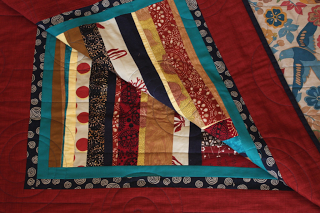In the 7th grade, my home-ec teacher, Mrs. Payne — and yeah, we had a lot of fun with that — made me rip apart and redo my felt frog hand puppet three times, because it was so sloppy. I came from a family of accomplished seamstresses and was embarrassed by my failure to craft a passable amphibian. At the same time, I was defensive. If anyone had asked me what I wanted to make, would I have chosen that bug-eyed piece of felt? I don’t think so. Still, I knew that I was not measuring up.
For many years, my great-grandmother owned a fabric store in the heart of Marin County. We have a quilt she made by hand that stuns me with its intricacy. My grandmother didn’t quilt, but she could sew, knit, and crochet — and many years the whole family got matching hats, scarves, and slippers to prove it. And my mom? Well, I think my mom can do anything, but look, when I was just a little smidge and there wasn’t enough money for new clothes, she made us matching outfits . . .
After the frog-puppet fiasco and one terrible, tiered, flowered skirt that was oh-so-’78, I thought I’d sworn off sewing for good. Then, a few years ago, I saw an image of this quilt (“Roman Stripes” variation, 1997) by Gee’s Bend quilter Essie Bendolph Pettway and I flipped right out:
Lights on! Quilts don’t have to be like my great-grandma’s, with pieces carefully cut and measured to make prearranged patterns. They can be loose and wild, made up as we go along with anything we want — from worn-out jeans to store-bought finds. (If you’re not familiar with the folk-art quilters of Gee’s Bend, Alabama, I highly recommend these sources: a touching and powerful documentary film called The Quilts of Gee’s Bend and a gorgeous art book by the same name.)
To learn some quilting basics, I sought out artist and teacher Angie Woolman, who offers a class in freeform quilting at Stone Mountain & Daughter in Berkeley — and who, blessedly, is nothing like I remember Mrs. Payne. (Poor Mrs. Payne. She was probably a very nice woman.) At the end of class, I had a finished quilt top, but then I slowed way down on the rest — back, batting, quilting, binding. After two years and a lot of help from a very patient Angie, I finally finished my first quilt last week.
In truth, I did all the parts except for the actual quilting. I chose the fabric, sewed the front and back, completed the binding — but I had Angie quilt it with a simple design, using her room-sized longarm quilting machine. That doesn’t mean I’m off the hook, however.
At our cabin in Alaska, where almost all of life is made by hand, I’ve started a quilt with Stewart’s old work clothes. I’ve pieced it together over the past two summers, but this year’s challenge is daunting. It’s time to put the front with the back and begin quilting. No sewing machine, no emails to Angie, no running to the the fabric store for the things I’m sure to forget. We’re miles away from any road and hours away from sewing supplies.
I’ll report back in September.







